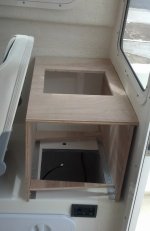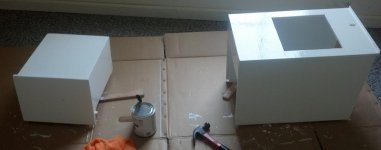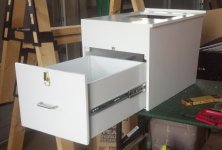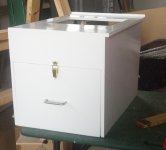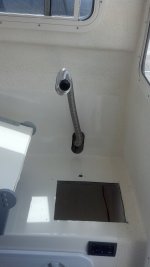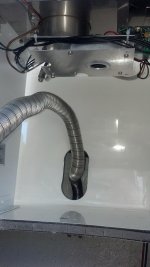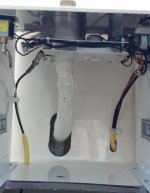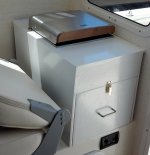mgarr682
New member
- Joined
- Sep 29, 2012
- Messages
- 182
- Reaction score
- 0
- C Dory Year
- 2013
- C Dory Model
- 22 Angler
- Hull Identification Number
- CMC22002J213
- Vessel Name
- Glenda Jean
Sea Wolf":3iv8rskr said:How about I play Devil's Advocate? :twisted:
Excellent, that's why I posted here, to get other ideas or to get a feel for the practicality of what I'm wanting to do.
Sea Wolf":3iv8rskr said:How much volume of storage space are you really going to gain, and at what cost and effort?
The space gained won't be all that great. Actual storage area will be (going from memory here, my notebook with those measurements is in the boat right now) about ten inches high, ten inches side to side (bow to stern, actually) and eighteen inches deep. The cabinet would be taller over all but the top several inches would contain the stove and not be useable for storage. I've already decided that drawers would waste a lot of the space and plan to build it with a hinged door that pivots down allowing a tackle tray or two to be slid out onto the door, needed items grabbed, tray slid back in and door closed.
Cost won't be much. A bit of 1/2 inch plywood for the top, 1/4 inch plywood for one side and the door, a bit of plank lumber cut to size for attachment points and to stiffen the door, a hinge or two, and a quart of white latex enamel paint would be the only things I'd have to buy. Epoxy glue and a variety of stainless screws, bolts, and silicon bronze ring nails are waiting in the basement. I debated using Starboard but after finding out how expensive and heavy it is I'll stick with plywood.
Effort won't be a lot either. I'll attach the counter top at the rear to the forward face of the aft bulkhead and along the side of the cabin in the same manner. I'll only have to cover the side behind the pilot seat and the door by using the side wall of the cabin and the rear bulkhead as walls of the cabinet.
Sea Wolf":3iv8rskr said:Is there another space on board you could build an equivalent or larger tackle box and not have to move the stove in the process?
There are several places on board where a tackle box could be stored, three large compartments under the berth, two large compartments under the dinette seats and the area under where the stove is located now. All of those compartments are large enough for a good sized tackle box but none would be as convenient as reaching through the door, lowering the cabinet door, sliding out the tackle tray, grabbing whatever leaders, hooks, weights, lures, etc., are needed, sliding the tray back in and closing the door.
Sea Wolf":3iv8rskr said:For example, over to the starboard side of the foot well and below the motor controls is an relatively large empty space that could serve to house a storage box or cabinet.
On my boat that area is closed off by a fiberglass wall. The starboard side storage cabinet and foot rest area are an insert with a vertical wall going all the way up to the cabin side. This photo shows the starboard side insert I'm talking about:
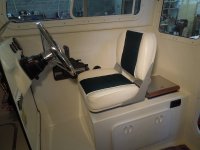
The area behind that wall is no more than six to eight inches deep. If I were to put a hatch there and the tackle box would fit it still wouldn't be nearly as convenient as what I have in mind.
Sea Wolf":3iv8rskr said:I routinely keep such storage boxes in the sink, on the covered 3-burner stove, or on the dinette table when fishing in my CD-22.
Yes, the benefits of that giant counter in the cruiser! The small cabin is the one downside to the Angler model. But, there is no way to get that big cockpit without making the cabin smaller. I could just use a tackle box but they always seem to be in the way or buried in a compartment somewhere. If they are on deck they are getting kicked over. I just want convenient, quick access to my tackle when I need it but out of the way at any other time.
Sea Wolf":3iv8rskr said:Such a box could be purchased in an already made configuration, eliminating the wood shop project, too, for better or for worse(!).
I've looked and have yet to find anything that will fit that narrow, tall, and deep space unless I get one custom made which is stupidly expensive.
Sea Wolf":3iv8rskr said:Another consideration: What dangers are there to having a hot coffee pot behind your head, or will it be there under way? I know you plan to contain it somehow, but …………………?
No coffee making or cooking when underway. The heater, now that is a different animal. That will get used a lot during the colder months whether at anchor or underway. I've used it several times while working on the boat in the last few weeks on cold days. I'm impressed.
Sea Wolf":3iv8rskr said:Also, have you considered where the hot air will be directed when using the stove as a heater?
It will already be that much higher when exiting the Wallas.
As it is installed now the stove/heater is much lower in the Angler than in the cruiser. According to the measurements Sunbeam gave me what I have in mind will raise it to about the same height as the counter top in the Cruiser model or maybe an inch or so higher. I'm thinking it should heat the cabin just as well from that height. The small cabin helps. I've run it on days when the temps were in the low 30's and it gets quite cozy. I've installed two fans under the shelf below the roof to direct warm air on the windshields for defogging and I suspect they will do fine just circulating the warmed air in the cabin. I have considered a third Caframo fan to direct the war air into the berth when overnighting.
Sea Wolf":3iv8rskr said:Sorry, just a few second-guess thoughts for free! :lol:
Joe. :teeth :thup
Your thoughts are appreciated! I've gotten several good tips and ideas from the discussions here at C-Brats!
Thanks!

